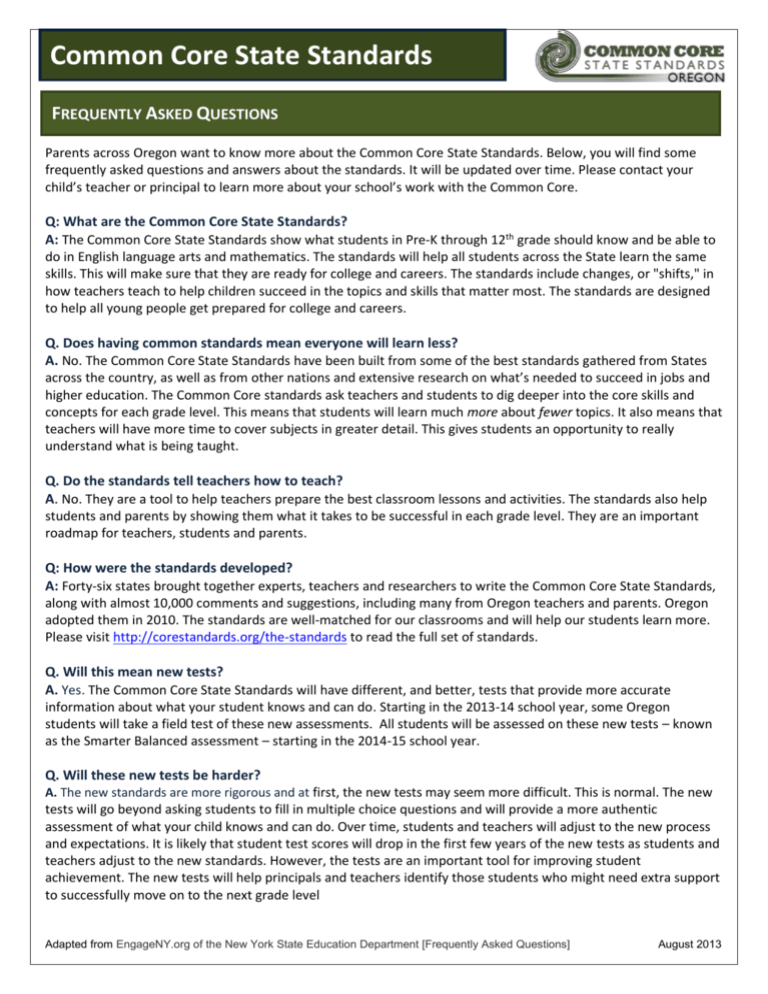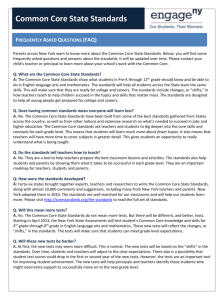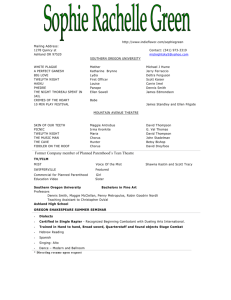Parent Workshop FAQ
advertisement

Common Core State Standards FREQUENTLY ASKED QUESTIONS Parents across Oregon want to know more about the Common Core State Standards. Below, you will find some frequently asked questions and answers about the standards. It will be updated over time. Please contact your child’s teacher or principal to learn more about your school’s work with the Common Core. Q: What are the Common Core State Standards? A: The Common Core State Standards show what students in Pre-K through 12th grade should know and be able to do in English language arts and mathematics. The standards will help all students across the State learn the same skills. This will make sure that they are ready for college and careers. The standards include changes, or "shifts," in how teachers teach to help children succeed in the topics and skills that matter most. The standards are designed to help all young people get prepared for college and careers. Q. Does having common standards mean everyone will learn less? A. No. The Common Core State Standards have been built from some of the best standards gathered from States across the country, as well as from other nations and extensive research on what’s needed to succeed in jobs and higher education. The Common Core standards ask teachers and students to dig deeper into the core skills and concepts for each grade level. This means that students will learn much more about fewer topics. It also means that teachers will have more time to cover subjects in greater detail. This gives students an opportunity to really understand what is being taught. Q. Do the standards tell teachers how to teach? A. No. They are a tool to help teachers prepare the best classroom lessons and activities. The standards also help students and parents by showing them what it takes to be successful in each grade level. They are an important roadmap for teachers, students and parents. Q: How were the standards developed? A: Forty-six states brought together experts, teachers and researchers to write the Common Core State Standards, along with almost 10,000 comments and suggestions, including many from Oregon teachers and parents. Oregon adopted them in 2010. The standards are well-matched for our classrooms and will help our students learn more. Please visit http://corestandards.org/the-standards to read the full set of standards. Q. Will this mean new tests? A. Yes. The Common Core State Standards will have different, and better, tests that provide more accurate information about what your student knows and can do. Starting in the 2013-14 school year, some Oregon students will take a field test of these new assessments. All students will be assessed on these new tests – known as the Smarter Balanced assessment – starting in the 2014-15 school year. Q. Will these new tests be harder? A. The new standards are more rigorous and at first, the new tests may seem more difficult. This is normal. The new tests will go beyond asking students to fill in multiple choice questions and will provide a more authentic assessment of what your child knows and can do. Over time, students and teachers will adjust to the new process and expectations. It is likely that student test scores will drop in the first few years of the new tests as students and teachers adjust to the new standards. However, the tests are an important tool for improving student achievement. The new tests will help principals and teachers identify those students who might need extra support to successfully move on to the next grade level Adapted from EngageNY.org of the New York State Education Department [Frequently Asked Questions] August 2013 Q. What does this work mean for students with disabilities and English language learners? A. The standards will help teachers have more time to cover subjects in greater detail. This gives students an opportunity to really understand what is being taught. There is a clear guide for applying the standards to English language learners and students with disabilities. Also, all states will be working together to constantly improve upon these issues. This will result in a strong support system for all learners. Q. What will the Common Core State Standards mean for students across the country? A. The standards set clear expectations for student learning across the country. In the past, every state had its own set of different academic standards. This meant that U.S. students were learning different skills and concepts at different rates. The Common Core State Standards give all students an equal opportunity to learn the same high standards. This leads to a greater chance of success in college, career and life. Q: If standards are raised, is it more likely that students will drop out of school? A: No, it is not more likely that students will drop out of school. Research points out that many factors come together to cause a student to drop out of school. Research also shows that students want to be challenged more in school. For example, 7 in 10 young people who had dropped out said they were not motivated or inspired to work hard in high school. Two-thirds of the dropouts said they would have worked harder if more was demanded of them (such as with higher academic expectations, more studying and more homework).1 Q: Is the adoption of common core standards in English language arts and mathematics going to limit student access to other subject areas, such as the arts or career and technical education? A: No. Oregon understands the importance that all subjects have in preparing students for success beyond high school. Graduating well-rounded students is important for the state’s future. The clearer standards of the Common Core will actually help teachers integrate learning across subject areas. This means that students will be given lessons that bring together mathematics, science, social studies, English language arts and other subjects. Q: Do the Common Core State Standards penalize students in low-performing schools by creating unrealistically high expectations? A: No. All too often, students in low performing schools today are held to lower expectations. Oregon has adopted the Common Core State Standards so that all students receive an excellent education. Glossary: Shift – A change in how teachers teach and how students learn Text – Any written work Non-fiction – Texts about real-life events or facts Evidence – Bits of proof from the text Arguments – How students convince someone of something Judgment – A student’s conclusion about what they have read Focus – Learning more on fewer topics Speed and Accuracy – How quickly a student can solve math problems correctly Sources: Common Core State Standards Initiative: http://www.corestandards.org/ Council of Great City Schools: http://www.cgcs.org Common Core Oregon: www.ode.state.or.us/go/commoncore National PTA: http://pta.org 1 Civic Enterprises. The Silent Epidemic: Perspectives of High School Dropouts. March 2006. http://www.saanys.org/uploads/content/TheSilentEpidemic-ExecSum.pdf Adapted from EngageNY.org of the New York State Education Department [Frequently Asked Questions] August 2013











